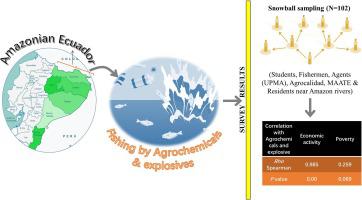使用农用化学品和爆炸物非法捕捞是一个不受控制的问题,对水生生态系统造成长期、不可逆转的损害。本次调查是根据新闻消息来源报道的案件进行的,概述了厄瓜多尔全国范围内这种令人不快的做法。为了验证新闻信息,在厄瓜多尔亚马逊地区针对六个人群进行了 102 项调查:学生、钓鱼者、UPMA(环境警察部队)警察、Agrocalidad、MAATE(环境、水和生态转型部)工作人员和亚马逊居民,按各自省份分类。调查结果证实,49%的参与者了解亚马逊渔业中非法使用农用化学品和炸药的情况。众所周知,主要是河边社区会在旱季进行这种做法。已查明的农用化学品按使用频率排序如下:鱼藤酮(26%)、棕榈醇(19%)、Nuvan(3%)、Methavin(2%);以及炸药 (9%);用于提高鱼类捕获率。根据克鲁斯卡尔-沃利斯测试,亚马逊各省之间每年使用农用化学品或炸药进行捕捞的频率存在显着差异;究其原因,是各省之间的收入来源和水平存在差异。因此,Rho 为 0.985 的 Spearman 系数证明了渔民的经济状况与不可持续捕捞(使用农用化学品-爆炸物)之间存在密切关系。按使用频率排名如下:鱼藤酮(26%)、棕榈醇(l9%)、Nuvan(3%)、Methavin(2%);以及炸药 (9%);用于提高鱼类捕获率。根据克鲁斯卡尔-沃利斯测试,亚马逊各省之间每年使用农用化学品或炸药进行捕捞的频率存在显着差异;究其原因,是各省之间的收入来源和水平存在差异。因此,Rho 为 0.985 的 Spearman 系数证明了渔民的经济状况与不可持续捕捞(使用农用化学品-爆炸物)之间存在密切关系。按使用频率排名如下:鱼藤酮(26%)、棕榈醇(l9%)、Nuvan(3%)、Methavin(2%);以及炸药 (9%);用于提高鱼类捕获率。根据克鲁斯卡尔-沃利斯测试,亚马逊各省之间每年使用农用化学品或炸药进行捕捞的频率存在显着差异;究其原因,是各省之间的收入来源和水平存在差异。因此,Rho 为 0.985 的 Spearman 系数证明了渔民的经济状况与不可持续捕捞(使用农用化学品-爆炸物)之间存在密切关系。亚马逊流域各省之间每年使用农用化学品或炸药进行捕捞的频率存在显着差异;究其原因,是各省之间的收入来源和水平存在差异。因此,Rho 为 0.985 的 Spearman 系数证明了渔民的经济状况与不可持续捕捞(使用农用化学品-爆炸物)之间存在密切关系。亚马逊流域各省之间每年使用农用化学品或炸药进行捕捞的频率存在显着差异;究其原因,是各省之间的收入来源和水平存在差异。因此,Rho 为 0.985 的 Spearman 系数证明了渔民的经济状况与不可持续捕捞(使用农用化学品-爆炸物)之间存在密切关系。 ( p≤0.005 )。综上所述,使用农用化学品和炸药是厄瓜多尔亚马逊地区常见的捕鱼方法。这种做法与他们的收入来源有关,例如采矿和农业。这与控制农用化学品和炸药商业化的难度有关,无论是通过走私还是在各种农药中添加活性成分。鉴于非法捕捞水生生态系统造成不可逆转的不利影响,厄瓜多尔政府和环境机构大力支持采取严格的行动植物来保护水生动植物群。
 "点击查看英文标题和摘要"
"点击查看英文标题和摘要"
Unsustainable fishing in Amazonian Ecuador involving agrochemicals and explosives detected by media surveys and stakeholder perception
Illegal fishing with agrochemicals and explosives is an uncontrolled problem that is causing long-lasting, irreversible damage to the aquatic ecosystems. The present investigation was carried out based on cases reported by journalistic sources, which provided an overview of this unpleasant practice nationwide in Ecuador. To validate journalistic information, 102 surveys were conducted in the Ecuadorian Amazon in six population groups: students, anglers, UPMA (The Environmental Police Unit) police officers, Agrocalidad, MAATE (Ministry of the Environment, Water and Ecological Transition) staff, and Amazon residents, categorized by their respective provinces. The survey results confirmed that 49% of participants knew about the illegal use of agrochemicals and dynamite in Amazonian fishing. Predominantly riverside communities were known to carry out this practice during the dry season. The identified agrochemicals, ranked by frequency of use were as follows: Rotenone (26%), Palmarol (l9%), Nuvan (3%), Methavin (2%); as well as Dynamite (9%); which were used to increase the fish catching rates. According to the Kruskal-Wallis test, the frequency of annual fishing with agrochemicals or explosives was significantly differ between the Amazonian provinces; attributed to differences in the sources and level of incomes between the provinces. Therefore, a strong relationship between the economic status of fishermen and the unsustainable fishing (using agrochemicals-explosives)was evidenced by the Spearman coefficient, with a Rho of 0.985 (p ≤ 0.005). In summary, the use of agrochemicals and explosives is a common fishing method in the Ecuadorian Amazon. This practice is associated with their sources of income, such as mining, and agriculture. It is linked to the difficulty of controlling the commercialization of agrochemicals and dynamite, either through contraband or the inclusion of the active ingredient in a wide range of pesticides. Given the irreversible adverse impact of illegal fishing aquatic ecosystems, stringent action plants are greatly warranted by the Ecuadorian government and environmental agencies to protect the aquatic flora and fauna.



































 京公网安备 11010802027423号
京公网安备 11010802027423号